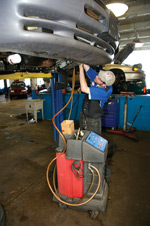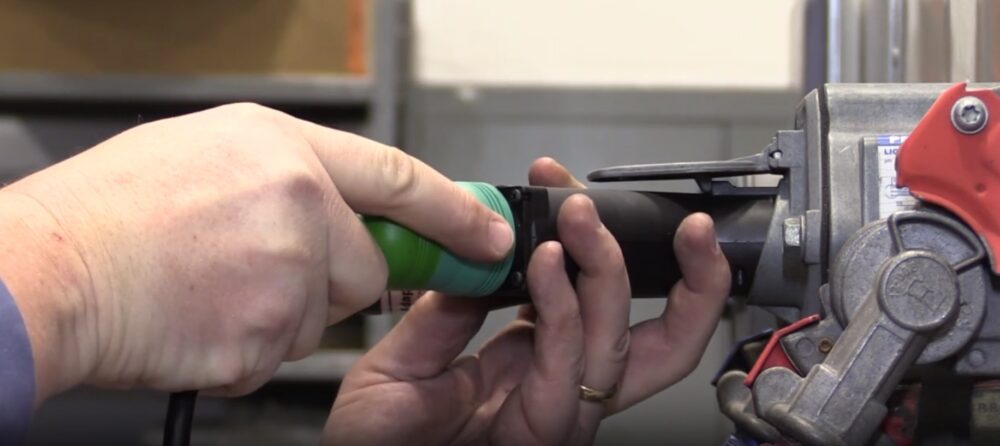 Vital fluids that need to be replaced periodically for preventive maintenance include engine oil, coolant, transmission fluid, gear oil, power steering fluid and brake fluid. Though many owner’s manuals only specify service intervals for engine oil and coolant, changing these other fluids can help prolong the life of any vehicle.
Vital fluids that need to be replaced periodically for preventive maintenance include engine oil, coolant, transmission fluid, gear oil, power steering fluid and brake fluid. Though many owner’s manuals only specify service intervals for engine oil and coolant, changing these other fluids can help prolong the life of any vehicle.
Oil changes usually don’t require any special equipment other than an assortment of different sized filter wrenches. But if the vehicle owner has not changed their vehicle’s oil regularly and the engine contains a lot of varnish and sludge, cleaning out the gunk with an oil flushing machine should be recommended. An engine oil flushing machine circulates a detergent solution through the engine’s lubrication system to loosen and remove the harmful deposits. The cleaning solution is then routed back through the machine and filtered to trap the deposits. The process typically takes about 30 minutes.
Coolant changes used to be a fairly simple drain and fill procedure, too. But today’s smaller capacity cooling systems with pressurized coolant reservoirs and heater circuits that often trap air make coolant changes much more challenging. Draining the radiator can often leave several quarts or more of old coolant in the engine block. So for this type of work, an efficient coolant exchange/flush machine can be a real time-saver.
Most coolant exchange/flush machines can replace the old coolant in 15 minutes or less. Some can do the job in as little as five minutes or less, depending on the capacity of the cooling system. Some machines require a tee fitting to be installed in one of the heater hoses or upper radiator hose, while others use a single hose connection at the radiator filler cap or coolant reservoir to siphon out the old coolant and replace it with fresh coolant.
Cleaning chemicals can also be used with a coolant exchanger to clean dirty cooling systems. The chemicals are circulated through the system during the flush cycle to loosen rust and scale for better heat transfer and longer coolant life.
Most coolant exchange machines are powered by shop air, but some use 12-volt DC motors. A vacuum pump or venturi siphons the old coolant out of the system and replaces it with fresh coolant. This technique provides an 85% to 98% exchange rate (depending on the machine), and prevents air from being trapped inside the cooling system. Trapped air can prevent coolant from completely refilling the system, and can be difficult to remove. Some machines also allow you to hold a vacuum on the system to check for leaks before it is refilled with fresh coolant.
One thing to look for when buying a coolant exchange/flush machine is its coolant storage capacity (both new and used). The larger the capacity of the storage tanks, the more jobs you can do before you have to add more coolant or remove the old coolant. Many machines have 8-gallon storage tanks that can handle up to four coolant flushes before the tanks need to be refilled or drained.
Some machines also have two or three separate storage tanks to hold different types of coolant, one for Dex-Cool, one for other OAT-based, long-life coolant (a hybrid HOAT or an import formula coolant), and possibly a third tank for older-style conventional green coolant or another specialty coolant.
Transmission fluid changes are not needed as often as they once were thanks to the long-life synthetic ATFs that are now used in most late-model electronic automatic transmissions. Even so, the life of the fluid is still affected by heat. Towing, aggressive driving and high ambient temperatures can all cause oxidation that shortens the life of any transmission fluid.
Like coolant changes, a simple drain and fill doesn’t do a very thorough job. Draining the transmission leaves as much as a gallon or more of old fluid inside the torque converter. The only way to do a thorough job of changing the fluid is to use a transmission fluid exchange machine.
ATF exchange machines are quick and easy to use, and the whole process only takes about 10 to 15 minutes. On most vehicles, the fluid is exchanged while the engine is idling with the transmission in Park. But on Mitsubishi vehicles and Chrysler and Hyundai models with Mitsubishi transmissions, oil does not flow to the ATF cooler when the transmission is in Park. You have to put it in Neutral (remember to set the parking brake!).
Some fluid exchange/flush machines also allow the use of a cleaner product to remove varnish and sludge from neglected transmissions. If the machine has a pressure gauge, you can use it to detect possible restrictions in the transmission fluid circuit (filter, lines or ATF cooler). Normal pressure readings may be as low as 8 to 10 psi with some vehicles. Readings less than 8 psi may indicate a restriction.
Always use ATF that meets the vehicle manufacturer’s requirements. Refer to the owner’s manual or dipstick for the type of fluid required. Using the wrong type of fluid may cause shift problems and possible transmission damage!
For manual transmissions, differentials and 4WD transfer cases, a drain and fill may be all that’s needed to replace the old gear oil with new. But on many gear boxes and differentials, there’s no drain plug. This requires a universal fluid exchange machine that can siphon the old fluid out of the filler opening. Some of these machines use a powerful 110-volt pump that can pull out thicker oils with ease.
Though most motorists think power steering fluid is a “lifetime” fluid that never needs to be changed, like any lubricant it oxidizes and breaks down over time. The fluid constantly circulates between the power steering pump and steering gear, so any wear particles or dirt that find their way into the fluid recirculate over and over between these components. There’s no filter in the power steering system, so eventually the contaminants cause wear in the pump seals and steering gear seals. Replacing the fluid every 50,000 miles can eliminate that type of wear and prolong the life of the power steering pump and steering gear. The fresh fluid will also contain anti-wear agents and seal conditioners that are usually depleted in the old fluid.
Power steering fluid exchange machines are similar to those used for coolant changes. The machine hooks up to the pump reservoir to pull out the old fluid and replace it with fresh fluid. The job takes just a few minutes.
Brake fluid is another fluid that is often neglected. Technicians should always change the fluid when doing a brake job or when replacing any hydraulic components such as the master cylinder, caliper, wheel cylinders, or brake lines or hoses. But there are also benefits to changing the fluid every three to four years for preventive maintenance, too.
Brake fluid is hygroscopic and absorbs moisture. Over time, this depletes the corrosion inhibitors in the fluid and also raises its boiling temperature (which increases the risk of fluid boil and brake pedal fade if the brakes get too hot). Changing the fluid whether the brakes need other work or not gets rid of the moisture and restores the corrosion inhibitors that protect the hydraulic components against internal rust and pitting. This is especially important with expensive anti-lock brake modular assemblies. Rust and sediment in the fluid can cause ABS solenoid valves to stick or leak, which may cause a loss of pedal under some circumstances or no anti-lock braking.
Brake flushing equipment includes air-powered bleeders and vacuum bleeders. Power bleeders push fluid through the system from the master cylinder reservoir, which requires opening all of the bleeder screws at each wheel. Vacuum bleeders, by comparison, pull the fluid through the system from the master cylinder one line after connecting the bleeder to the bleeder valve at each caliper or wheel cylinder. Both do an excellent job of flushing out the old contaminated fluid along with any air that might be in the lines or hydraulic components.


